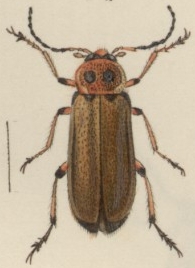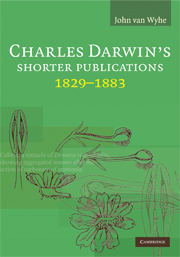Darwin's insects in Stephens' Illustrations of British entomology (1829-32)
An introduction by John van Wyhe and Kees Rookmaaker
 Charles Darwin was extremely proud when, as a student at Cambridge, his name appeared in these classic volumes on entomology. As he later recalled in his Autobiography:
Charles Darwin was extremely proud when, as a student at Cambridge, his name appeared in these classic volumes on entomology. As he later recalled in his Autobiography:
But no pursuit at Cambridge was followed with nearly so much eagerness or gave me so much pleasure as collecting beetles. It was the mere passion for collecting, for I did not dissect them and rarely compared their external characters with published descriptions, but got them named anyhow. I will give a proof of my zeal: one day, on tearing off some old bark, I saw two rare beetles and seized one in each hand; then I saw a third and new kind, which I could not bear to lose, so that I popped the one which I held in my right hand into my mouth. Alas it ejected some intensely acrid fluid, which burnt my tongue so that I was forced to spit the beetle out, which was lost, as well as the third one.
I was very successful in collecting and invented two new methods; I employed a labourer to scrape during the winter, moss off old trees and place [it] in a large bag, and likewise to collect the rubbish at the bottom of the barges in which reeds are brought from the fens, and thus I got some very rare species. No poet ever felt more delight at seeing his first poem published than I did at seeing in Stephen's Illustrations of British Insects the magic words, "captured by C. Darwin, Esq."
As has often been pointed out, this exact wording was not printed in Stephens. But the entry in volume 3 (p. 266) states: 'captured by the Rev. F. W. Hope and C. Darwin, Esq., in North Wales' and a newly discovered entry in the appendix to volume 5 is close to the mark "Taken in North Wales by C. Darwin, Esq."1
There are 92 words quoted from Darwin across 31 entries, with a further two entries naming him as the collector but without quotation.
Further detail is provided by R. B. Freeman below. See also: K. G. V. Smith's Darwin's insects. Text
DARWIN'S BRITISH INSECTS
There are four sources for Darwin's Cambridge insect collection:
1. The Edinburgh notebook CUL-DAR118 list of species.
2. Annotations in Darwin's copy of Stephens, A systematic catalogue of British insects. 1829 (CUL, MS room [i.e. the Darwin Library]).
3. Darwin's letters to W. D. Fox, 1828-1830.
4. Listings in Stephens, Mandibulata and Haustellata, 1829-1830 (cf. Darwin's insects)
The Edinburgh notebook, CUL-DAR118
Text & image
56 species. Dates: 8 records with dates, 1828 (1) and 1829 (7). Latest 1829 July or Summer
Provenance from other people:
Hope 4
Waterhouse 2
Weaver 2
Stephens 1829 Annotations
281 species. Dates: 43 records with dates, 1827 (2), 1828 (9), 1829 (32). Latest 1829 August
Provenance from other people:
Hays 1
Hope 19
Thompson 2
Waterhouse 15
Weaver 3
Out of the 281 species with Darwin's annotations, some remarks are difficult to interpret. On pp. 221-225, there are 17 species with a small x before them (included in the total). On pp. 1-60 there are 36 species with a symbol which looks like P for passim?
W. D. Fox Correspondence
53 species mentioned. Dates of letters 1828-1830.
Provenance from other people:
Hope 1
Stephens, Mandibulata and Haustellata
32 species. Dates: 7 records with dates, all 1829.
No provenance recorded.
Total 422 species in total.
Duplicate: 28
Triplicate: 3
Unique species (sometimes genus only) mentioned in these records total 390.
| Localities | Listings in Stephens |
Annotations in Stephens |
DAR118 |
|
Essex |
- |
1 |
- |
|
Barmouth |
3 |
16 |
5 |
|
B [=? Barmouth] |
- |
1 |
- |
|
Burwell Fen |
- |
2 |
- |
|
Cader |
- |
2 |
- |
|
Cambridge |
20 |
82 |
7 |
|
C [=? Cambridge] |
- |
20 |
- |
|
Chesterton |
- |
1 |
- |
|
Devon |
- |
11 |
- |
|
Gloucestershire |
- |
- |
1 |
|
Huntingdonshire |
- |
1 |
- |
|
Gravel pits |
- |
- |
1 |
|
Kent |
- |
- |
1 |
|
Maer |
- |
19 |
1 |
|
Netley |
- |
4 |
- |
|
North Wales |
8 |
6 |
- |
|
NW [=North Wales] |
- |
2 |
- |
|
Osmaston |
- |
1 |
- |
|
Passim |
- |
10 |
1 |
|
Salop |
2 |
- |
- |
|
Shrewsbury |
- |
29 |
6 |
|
Shropshire |
2 |
5 |
- |
|
Southend |
- |
- |
6 |
|
Streatham |
- |
4 |
1 |
|
Woodhouse |
- |
2 |
1 |
|
Total |
35 |
218 |
31 |
= 280 |
Available below are the title pages of the parts containing citations of Darwin and every page in which a species he collected or his name occurs. The beautiful plates to the volumes are also included.
Available in a separate document is the text by Darwin quoted in Stephens: Darwin 1829-1832.
The copy scanned was kindly provided by The Balfour and Newton Libraries, Cambridge.
John van Wyhe and Kees Rookmaaker
Stephens, J. F. 1829-1832. Illustrations of British Entomology, or, a Synopsis of indigenous insects: containing their generic and specific distinctions; with an account of their metamorphoses, times of appearance, localities, food, and economy, as far as practicable. Embellished with coloured figures of the rarer and more interesting species. London: Baldwin and Cradock.
Haustellata, Vol. 2. Image A120.1
Mandibulata, Vol. 2. Image A120.2
Mandibulata, Vol. 3. Image A120.3
Mandibulata, Vol. 4. Image A120.4
Mandibulata, Vol. 5. Image A120.5
Bibliographical introduction by R. B. Freeman

It is usually stated that Darwin's first published work, whether in periodical literature or in a book, is the Letters on geology, of 1835, which is No. 1 below. Strictly however his first printed words occur six years earlier in 1829.2 Whilst he was an undergraduate at Cambridge, Darwin had sent records of insects that he had captured to James Francis Stephens, and some of these were published in Illustrations of British entomology. He refers to the pleasure that he got from seeing his name in print against his records of beetles in his autobiography (Life and letters, Vol. I, p. 51) although he gets both the title of the work and the method of citation wrong. Stephens' classic work was published in parts between 1 May 1827 and November 1845, with a supplement in August 1846. The following is a short description of it:
Illustrations of British entomology; or, a synopsis of indigenous insects etc. 8vo, 245 mm, 11 vols, 80 coloured plates, Baldwin and Cradock for the author, London [1827-]1828-1835[-1845]; supplement, vi + 32 pp, 15 coloured plates, 1846.
The main work is divided into four volumes of Haustellata and seven of Mandibulata. The beetles occur in the first five volumes of the latter, and there are about thirty records bearing Darwin's name, the earliest being in an appendix to Volume II, which is dated June 15, 1829. The localities include Cambridge, North Wales and Shrewsbury. There is one further record which is earlier than this. In Haustellata, Volume II, p. 200, Darwin records the occurrence of the common noctuid moth Graphiphora plecta at 'Cambridge', and the date of this part is June 1, 1829. The modern scientific name of this moth is Ochropleura plecta (L.), and its common name the flame shoulder. In most cases these records are given in quotation marks, and therefore represent genuine publications by Darwin in a book.
Darwin's beetle records occur again in another of Stephens' works which is a revision of the relevant parts of the Illustrations, in an abridged form with the plates omitted. Darwin's name, like those of other correspondents, is however not printed. The following is a short description of it:
A manual of British Coleoptera or beetles etc. 8vo, 197 mm, vii + 443 pp, Longman, London 1839.
1829-1832. [Records of captured insects]. In Stephens, Illustrations of British entomology. Text PDF F1968
1 With thanks to J. David Archibald for informing us of this reference.
2 In fact Darwin's name first appeared in print in R. E. Grant. 1827. Notice regarding the ova of the Pontobdella muricata, Lam. Edinburgh Journal of Science 7 (July): 160-161: 'The merit of having first ascertained them [ova] to belong to that animal is due to my zealous young friend Mr Charles Darwin of Shrewsbury, who kindly presented me with specimens of the ova exhibiting the animal in different stages of maturity.'
JvW
NOTE: With thanks to The Charles Darwin Trust and Dr Mary Whitear for use of the Bibliographical Handlist. Copyright. All rights reserved. For private academic use only. Not for republication or reproduction in whole or in part without the prior written consent of The Charles Darwin Trust, 31 Baalbec Road, London N5 1QN.
Corrections and additions copyright The Complete Work of Charles Darwin Online.






